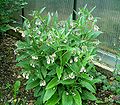Symphytum officinale: Difference between revisions
No edit summary |
No edit summary |
||
| Line 26: | Line 26: | ||
|image_width=240 | |image_width=240 | ||
}} | }} | ||
''' | '''''Symphytum officinale''''' is a [[perennial]] [[flowering plant]] of the genus ''[[Symphytum]]'' in the family [[Boraginaceae]]. Along with several other species of ''Symphytum'', it is commonly known as [[comfrey]]. | ||
The hardy plant can grow to a height of 60 cm. | |||
Comfrey has been used in [[folk medicine]] as a [[poultice]] for treating burns and wounds. However, internal consumption, such as in the form of [[herbal tea]], is discouraged, as it can cause serious liver damage.<ref>http://journals.cambridge.org/download.php?file=%2FPHN%2FPHN7_07%2FS1368980004001156a.pdf&code=f5f837200b6f79862cf84720c13bb8d5</ref> | |||
{{Inc| | {{Inc| | ||
Latest revision as of 19:58, 22 June 2010
| Symphytum officinale subsp. var. | Comfrey, Common comfrey, English comfrey | |||||||||||||||||||||||||||||||||||||||||||||||||||||||
|---|---|---|---|---|---|---|---|---|---|---|---|---|---|---|---|---|---|---|---|---|---|---|---|---|---|---|---|---|---|---|---|---|---|---|---|---|---|---|---|---|---|---|---|---|---|---|---|---|---|---|---|---|---|---|---|---|

|
|
| ||||||||||||||||||||||||||||||||||||||||||||||||||||||
| ||||||||||||||||||||||||||||||||||||||||||||||||||||||||
Symphytum officinale is a perennial flowering plant of the genus Symphytum in the family Boraginaceae. Along with several other species of Symphytum, it is commonly known as comfrey.
The hardy plant can grow to a height of 60 cm.
Comfrey has been used in folk medicine as a poultice for treating burns and wounds. However, internal consumption, such as in the form of herbal tea, is discouraged, as it can cause serious liver damage.[1]
| Standard Cyclopedia of Horticulture |
|---|
|
Symphytum officinale, Linn. (S. bohemicum, F. W. Schmidt). Perennial, about 3 ft. high: root thick: st. branched, white-pilose: lvs. slightly pilose, basal and lower cauline ovate - lanceolate, upper oblong-lanceolate, all broadly decurrent at base: fls. white, yellowish, purple, or rose, in drooping cymes. Eu., Asia. Var. argenteum, Hort., is offered in the trade as growing 2 ft. high, with silver-variegated foliage and drooping blue fls. Var. aureum, Hort., is offered in the trade as a golden variegated form growing 2 ft. high. Var. coccineum, Hort. (S. coccineum, Hort., ex Schlecht.), is offered in the trade as a scarlet-fld. form. Var. lilacinum, Hort., is offered in the trade. Var. purpureum, Pers. (S. officinale var. bohemicum, Don), has reddish purple fls. Eu. Var. variegatum, Hort., has lvs. widely margined with creamy white. F.S. 18:1901-1902. CH
|
Cultivation
Propagation
Pests and diseases
Varieties
Gallery
-
photo 1
-
photo 2
-
photo 3
References
External links
- w:Symphytum officinale. Some of the material on this page may be from Wikipedia, under the Creative Commons license.
- Symphytum officinale QR Code (Size 50, 100, 200, 500)


